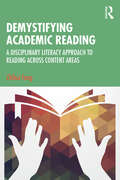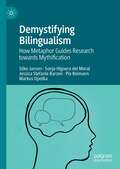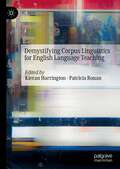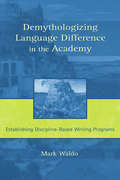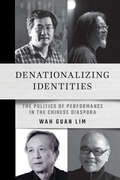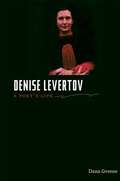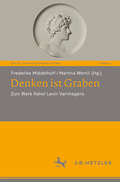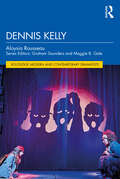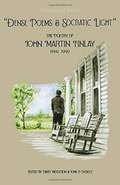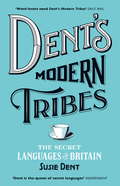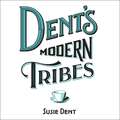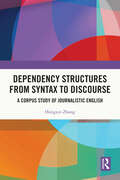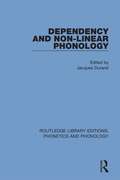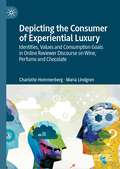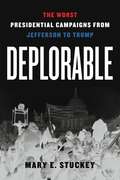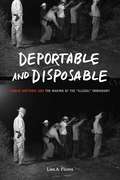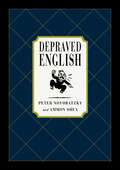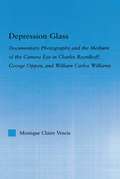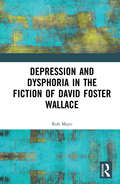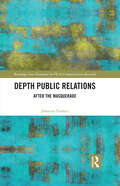- Table View
- List View
Demystifying Academic Reading: A Disciplinary Literacy Approach to Reading Across Content Areas
by Zhihui FangFoundational and accessible, this book equips pre-service and practicing teachers with the knowledge, understanding, tools, and resources they need to help students in grades 4–12 develop reading proficiencies in four core academic subjects—literature, history, science, and mathematics. Applying a disciplinary literacy approach, Fang describes the verbal and visual resources, expert strategies, inquiry skills, and habits of mind that students must learn in order to read carefully, critically, purposefully, and with an informed skepticism across genres and content areas. He also shows how teachers can promote language learning and reading/literacy development at the same time that they engage students in content area learning. With informative synthesis and research-based recommendations in every chapter, this text prepares teachers to help students develop discipline-specific, as well as discipline-relevant, discursive insights, literacy strategies, and ways of thinking, reasoning, and inquiring that are essential to productive learning across academic subjects. It also provides teacher educators with approaches and strategies for helping teacher candidates develop expertise in academic reading instruction. In so doing, the book demystifies academic reading, revealing what it takes for students to read increasingly complex academic texts with confidence and understanding and for teachers to develop expertise that promotes disciplinary literacy. This state-of-the-art text is ideal for courses on reading/literacy methods and academic literacy and eminently relevant to all educators who want their students to become thoughtful readers and powerful learners
Demystifying Bilingualism: How Metaphor Guides Research towards Mythification
by Silke Jansen Sonja Higuera del Moral Jessica Stefanie Barzen Pia Reimann Markus OpolkaThis book analyses changing views on bilingualism in Cognitive Psychology and explores their socio-cultural embeddedness. It offers a new, innovative perspective on the debate on possible cognitive (dis)advantages in bilinguals, arguing that it is biased by popular “language myths”, which often manifest themselves in the form of metaphors. Since its beginnings, Cognitive Psychology has consistently modelled the coexistence between languages in the brain using metaphors of struggle, conflict and competition. However, an ideological shift from nationalist and monolingual ideologies to the celebration of bilingualism under multicultural and neoliberal ideologies in the course of the 20th century fostered opposing interpretations of language coexistence in the brain and its effects on bilinguals at different moments in time. This book will be of interest to students and scholars of Cognitive Psychology, Psycholinguistics, Multilingualism and Applied Linguistics, Cognitive and Computational Linguistics, and Critical Metaphor Analysis.
Demystifying Corpus Linguistics for English Language Teaching
by Kieran Harrington Patricia RonanThe aim of this edited volume is to demystify corpus linguistics for use in English language teaching (ELT). It advocates the inclusion of corpus linguistics in the classroom as part of an approach to ELT in which students engage with naturally occurring language. The first chapter provides a basic but essential introduction to corpus linguistics, including sections on corpora and corpus methods, and this is followed by a review of the use of corpus linguistics in ELT. Chapters on the traditional ELT strands of skills, vocabulary and grammar as well as chapters on pluricentric approaches (on language and culture, World Englishes and English as a Lingua Franca) flow naturally from the second chapter, which reports on a survey of the attitudes of trainee teacher to the use of corpus linguistics in the ELT classroom. The final two chapters show how the work of corpus linguists can benefit classroom teacher preparation, materials development and textbook writing. This book will be of interest not only to academics in fields such as English Language Teaching, Applied Linguistics and Corpus Linguistics, but also to educators of teacher-trainees and teacher-trainees themselves, as well as teachers who are looking for new interactive approaches to ELT.
Demythologizing Language Difference in the Academy: Establishing Discipline-Based Writing Programs
by Mark WaldoIn this volume, Mark Waldo argues that writing across the curriculum (WAC) programs should be housed in writing centers and explains an innovative approach to enhancing their effectiveness: focus WAC on the writing agendas of the disciplines. He asserts that WAC operation should reflect an academy characterized by multiple language communities--each with contextualized values, purposes, and forms for writing, and no single community's values superior to another's. Starting off with an examination of the core issue, that WAC should be promoting learning to write in the disciplines instead of writing to learn, Waldo proposes: *housing WAC in comprehensive writing centers independent of any other department; *using dialogue and inquiry rather than prescriptive techniques in the WAC program's interaction with faculty in other disciplines; and *phasing out writing assessment that depends on one test measuring the writing abilities of students from all disciplines. In the process of making his case, Waldo discusses tutor training, faculty consultancy, and multilayered assessment programs. In addition to presenting the theoretical and practical advantages of discipline-based WAC programs, he also offers clear and compelling evidence from his own institution that supports the success of this approach to writing instruction. Demythologizing Language Difference in the Academy: Establishing Discipline-Based Writing Programs will be of interest to writing program and WAC administrators; writing center administrators; graduate students studying composition; and educators and graduate students involved in WAC initiatives, research, and study.
Denationalizing Identities: The Politics of Performance in the Chinese Diaspora
by Wah Guan LimDenationalizing Identities explores the relationship between performance and ideology in the global Sinosphere. Wah Guan Lim's study of four important diasporic director-playwrights—Gao Xingjian, Stan Lai Sheng-chuan, Danny Yung Ning Tsun, and Kuo Pao Kun—shows the impact of theater on ideas of "Chineseness" across China, Taiwan, Hong Kong, and Singapore. At the height of the Cold War, the "Bamboo Curtain" divided the "two Chinas" across the Taiwan Strait. Meanwhile, Hong Kong prepared for its handover to the People's Republic of China and Singapore rethought Chinese education. As geopolitical tensions imposed ethno-nationalist identities across the region, these four dramatists wove together local, foreign, and Chinese elements in their art, challenging mainland China's narrative of an inevitable communist outcome. By performing cultural identities alternative to the ones sanctioned by their own states, they debunked notions of a unified Chineseness. Denationalizing Identities highlights the key role theater and performance played in circulating people and ideas across the Chinese-speaking world, well before cross-strait relations began to thaw.
Denise Levertov: A Poet's Life
by Dana GreeneKenneth Rexroth called Denise Levertov (1923-1997) "the most subtly skillful poet of her generation, the most profound, . . . and the most moving." Author of twenty-four volumes of poetry, four books of essays, and several translations, Levertov became a lauded and honored poet. Born in England, she published her first book of poems at age twenty-three, but it was not until she married and came to the United States in 1948 that she found her poetic voice, helped by the likes of William Carlos Williams, Robert Duncan, and Robert Creeley. Shortly before her death in 1997, the woman who claimed no country as home was nominated to be America's poet laureate. Levertov was the quintessential romantic. She wanted to live vividly, intensely, passionately, and on a grand scale. She wanted the persistence of Cézanne and the depth and generosity of Rilke. Once she acclimated herself to America, the dreamy lyric poetry of her early years gave way to the joy and wonder of ordinary life. By the late 1960s and early 1970s, however, her poems began to engage the issues of her times. Vehement and strident, her poetry of protest was both acclaimed and criticized. The end of both the Vietnam War and her marriage left her mentally fatigued and emotionally fragile, but gradually, over the span of a decade, she emerged with new energy. The crystalline and luminous poetry of her last years stands as final witness to a lifetime of searching for the mystery embedded in life itself. Through all the vagaries of life and art, her response was that of a "primary wonder." In this illuminating biography, Dana Greene examines Levertov's interviews, essays, and self-revelatory poetry to discern the conflict and torment she both endured and created in her attempts to deal with her own psyche, her relationships with family, friends, lovers, colleagues, and the times in which she lived. Denise Levertov: A Poet's Life is the first complete biography of Levertov, a woman who claimed she did not want a biography, insisting that it was her work that she hoped would endure. And yet she confessed that her poetry in its various forms--lyric, political, natural, and religious--derived from her life experience. Although a substantial body of criticism has established Levertov as a major poet of the later twentieth century, this volume represents the first attempt to set her poetry within the framework of her often tumultuous life.
Denken ist Graben: Zum Werk Rahel Levin Varnhagens (Neue Romantikforschung #6)
by Frederike Middelhoff Martina WernliDie Schriften Rahel Levin Varnhagens (1771–1833) sind ästhetisch und thematisch komplex. Sie umfassen kleine Formen, u.a. Aphorismen und Lektürereflexionen, ebenso wie lange Tagebucheinträge und umfangreiche Briefwechsel mit beinahe dreihundert Personen. Auszüge ihrer Texte wurden bereits zur Lebzeit Levin Varnhagens publiziert. Die im vorliegenden Band versammelten Beiträge zielen darauf ab, Rahel Levin Varnhagens Texte sowie die damit verknüpften weitreichenden Lektüren und Kontexte in ihren materiellen, ästhetischen, poetologischen und soziohistorischen Dimensionen zu erkunden und vor dem Hintergrund romantischer Konzepte und epistolarer Kommunikationsformen zu diskutieren. Darüber hinaus gibt der Band Einblick in ausgewählte Handschriften (Tagebuch A) sowie in ein bislang unpubliziertes Ausgabenbuch der Romantikerin.
Dennis Kelly (Routledge Modern and Contemporary Dramatists)
by Aloysia RousseauDennis Kelly explores Kelly’s unusual career path and sheds light on his eclectic approach to the arts, characterised by a refusal to write texts that people can fit within neat categories. This is the first monograph on Kelly’s work for stage and screen and brings to light his essential contribution to contemporary British drama and his huge range of work including his rise to international fame with Matilda the Musical.Drawing on Kelly’s published and unpublished texts, his work in production, reviews, original interviews with directors, actors and with Kelly himself as well as critical theory, Dennis Kelly examines and reappraises key motifs in his work such as his preoccupation with violence, the complex relationship between the individual and the community or his emphasis on storytelling. It also offers new insights into overlooked aspects of Kelly’s work by setting out to explore his traumatic narratives and his post-romanticism. In keeping with Kelly’s wish never to repeat himself, this study offers multiple critical entries into his plays, television series and films, drawing on moral and political philosophy, trauma studies, studies in humour, feminist theory and film studies.Part of the Routledge Modern and Contemporary Dramatist series, Dennis Kelly is addressed to students and scholars in Drama, Theatre and Performance as well as theatre practitioners and offers in-depth analysis of one of the most unique and challenging voices in contemporary British playwriting and screenwriting.
Dense Poems and Socratic Light: The Poems of John Martin Finlay
by David Middleton John Martin Finlay John P DoucetThis Wiseblood Book edition of Finlay’s poetry and related writings is the most comprehensive edition to date, including many previously uncollected and unpublished materials. John Finlay’s poems are almost all in traditional literary forms. Whether plain-style, narrative, or post-symbolist, Finlay’s poems are serious, simple, deep, direct, and often traumatically revealing of the human condition. The best of them are truly unforgettable. <p><p> Finlay addresses such subjects as the origin of the mind, the relation of mind and matter, mind and the irrational, mind and God, the nature of evil, Thomistic theology, philosophical subjectivism, the inscrutability and beauty of the natural world, primitive religious rituals, and, especially in the later poems, family life in the South since the early nineteenth century, Indian life in the South, the nature of modern war, and the isolation of the serious thinker and artist in the contemporary world. <p> Readers who want serious poems that vividly present sensuous experience as understood by a mature mind steeped in classical and Christian tradition, yet fully aware of the problems of the contemporary world and of the perpetual threat of the primitive and the irrational, should find much here to contemplate. In their severe and uncompromising grandeur John Finlay’s best poems are surely permanent additions to American literature.
Dent's Modern Tribes: The Secret Languages of Britain
by Susie DentDid you know that . . . a soldier's biggest social blunder is called jack brew - making yourself a cuppa without making one for anyone else? That twitchers have an expression for a bird that can't be identified - LBJ (the letters stand for Little Brown Job)? Or that builders call plastering the ceiling doing Lionel Richie's dancefloor? Susie Dent does.Ever wondered why football managers all speak the same way, what a cabbie calls the Houses of Parliament, or how ticket inspectors discreetly request back-up? We are surrounded by hundreds of tribes, each speaking their own distinct slanguage of colourful words, jokes and phrases, honed through years of conversations on the battlefield, in A&E, backstage, or at ten-thousand feet in the air. Susie Dent has spent years interviewing hundreds of professionals, hobbyists and enthusiasts, and the result is an idiosyncratic phrasebook like no other. From the Freemason's handshake to the publican's banter, Dent's Modern Tribes takes us on a whirlwind tour of Britain, decoding its secret languages and, in the process, finds out what really makes us all tick.
Dent's Modern Tribes: The Secret Languages of Britain
by Susie DentDid you know that . . . a soldier's biggest social blunder is called jack brew - making yourself a cuppa without making one for anyone else? That twitchers have an expression for a bird that can't be identified - LBJ (the letters stand for Little Brown Job)? Or that builders call plastering the ceiling doing Lionel Richie's dancefloor? Susie Dent does.Ever wondered why football managers all speak the same way, what a cabbie calls the Houses of Parliament, or how ticket inspectors discreetly request back-up? We are surrounded by hundreds of tribes, each speaking their own distinct slanguage of colourful words, jokes and phrases, honed through years of conversations on the battlefield, in A&E, backstage, or at ten-thousand feet in the air. Susie Dent has spent years interviewing hundreds of professionals, hobbyists and enthusiasts, and the result is an idiosyncratic phrasebook like no other. From the Freemason's handshake to the publican's banter, Dent's Modern Tribes takes us on a whirlwind tour of Britain, decoding its secret languages and, in the process, finds out what really makes us all tick.
Dent's Modern Tribes: The Secret Languages of Britain
by Susie DentDid you know that . . . a soldier's biggest social blunder is called jack brew - making yourself a cuppa without making one for anyone else? That twitchers have an expression for a bird that can't be identified - LBJ (the letters stand for Little Brown Job)? Or that builders call plastering the ceiling doing Lionel Richie's dancefloor? Susie Dent does.Ever wondered why football managers all speak the same way, what a cabbie calls the Houses of Parliament, or how ticket inspectors discreetly request back-up? We are surrounded by hundreds of tribes, each speaking their own distinct slanguage of colourful words, jokes and phrases, honed through years of conversations on the battlefield, in A&E, backstage, or at ten-thousand feet in the air. Susie Dent has spent years interviewing hundreds of professionals, hobbyists and enthusiasts, and the result is an idiosyncratic phrasebook like no other. From the Freemason's handshake to the publican's banter, Dent's Modern Tribes takes us on a whirlwind tour of Britain, decoding its secret languages and, in the process, finds out what really makes us all tick.(P)2016 John Murray Press
Deontic Logic and Legal Systems
by Pablo E. Navarro Jorge L. RodrÍguez Eugenio Bulygin Pablo E. Navarro Jorge L. RodríguezA considerable number of books and papers have analyzed normative concepts using new techniques developed by logicians; however, few have bridged the gap between the Continental (i. e. , European) and Latin American traditions in legal philosophy. This book addresses this issue by offering an introductory study on the many possibilities that logical analysis offers the study of legal systems. The volume is divided into two sections: The first covers the basic aspects of classical and deontic logic and its connections, advancing an explanation of the most important topics of the discipline by comparing different systems of deontic logic and exploring some of the most important paradoxes in its domain. The second section deals with the role of logic in the analysis of legal systems by discussing in what sense deontic logic and the logic of norm-propositions are useful tools for a proper understanding of the systematic structure of law. Arguments are provided to stress the relevance of a systematic reconstruction of law as a necessary step in the identification of the truth conditions of legal statements and the reasons for accepting or rejecting the validity of logical consequences of enacted legal norms.
Dependency Structures from Syntax to Discourse: A Corpus Study of Journalistic English
by Hongxin ZHANGBased on the large corpora of journalistic English, this title examines dependency relations and related properties at both syntactic and discourse levels, seeking to unravel the language patterns of real-life usage. With a focus on rank-frequency distribution, the author investigates the distribution of linguistic properties/units from the perspectives of properties, motifs and sequencings. At the syntactic level, the book analyses the following three dimensions: various combinations of a complete dependency structure, valency and dependency distance. At the discourse level, it proves that the elements can also form dependency relations by exploring (1) the rank-frequency distribution of Rhetorical Structure Theory relations, their motifs, discourse valency and discourse dependency distance; (2) whether there is top-down organisation or an inverted pyramid structure at all the three discourse levels; and (3) whether discourse dependency distances and valencies are lawfully distributed, following the same distribution patterns as those at the syntactic level. This book will be of great value for scholars and students of quantitative linguistics and computational linguistics and its practical insights will also benefit professionals of language teaching and journalistic writing.
Dependency and Non-Linear Phonology (Routledge Library Editions: Phonetics and Phonology #5)
by UnknownFirst published in 1986. The purpose of this collection of articles is to explore in depth the notational model dependency phonology, and also to offer rival, non-dependency-based accounts of aspects of suprasegmental and intrasegmental structure. Dependency and Non-Linear Phonology offers an introduction to dependency phonology that does not presuppose any knowledge of this framework and points out some of the major differences between dependency phonology and competing systems of representations. The book will also act as a guide to current debates in the field of ‘non-linear’ phonology.
Depersonalization and Creative Writing: Unreal City (Routledge Studies in Creative Writing)
by Matthew FrancisDepersonalization and Creative Writing: Unreal City explores the common psychological symptom of depersonalization, its influence on literature and the insights it can provide into the writing process. Depersonalization is a distressing symptom in which sufferers feel detached from their own selves and the world. Often associated with psychological disorders, it can also affect healthy people at times of stress. Beginning with a first-hand account of the experience, the book goes on to argue that many well-known literary texts, including Camus’s The Outsider and Sartre’s Nausea, evoke a similar psychological state. It shows how a concept of depersonalized writing can be found in the work of literary theorists from widely different traditions, including T.S. Eliot, Roland Barthes and Viktor Shklovsky. Finally, it maintains that creative writers can make use of the lessons learned from a study of depersonalization to arrive at a deeper understanding of writing. Given this knowledge, the controversial writing teacher’s maxim show, don’t tell, so often misapplied or misunderstood, can be repurposed as a practical instruction for taking students’ writing to a new level of sophistication and wisdom.
Depicting the Consumer of Experiential Luxury: Identities, Values and Consumption Goals in Online Reviewer Discourse on Wine, Perfume and Chocolate
by Charlotte Hommerberg Maria LindgrenThis book sheds light on the addressees of online reviewer discourse on wine, perfume and chocolate in order to explore how the discourse construes the consumer of experiential luxury. In the 21st century, luxury is more complex than ever before. Luxury products have become more affordable and hence accessible to new markets and consumer segments, and the groups of consumers seeking luxury experiences are more heterogeneous than ever. Yet, consumption choices as well as how these are thought about, evaluated and talked about still function to position consumers with respect to both how they see themselves and how they want others to see them. Many consumers seek to consume in subtle and sophisticated ways. They strive to develop consumption expertise with a view to maximizing their enjoyment from the luxury experience, avoiding overt displays of wealth while signalling status by means of luxury insight only available to the cognoscenti. One way for aficionados to develop their insight into the diversified and elusive realm of contemporary luxury is to engage with online reviewer discourse. The authors take a discourse analytic approach informed by the Appraisal model to expose the imagined addressees’ characteristics and behaviour, the luxury values they embrace and the goals of their luxury consumption. The authors argue that the activity of online reviewers is such a crucial arena in contemporary luxury that a new form of luxury consumption has emerged, which they label review-based luxury. This book will be of interest to students and academics in the fields of Linguistics, Discourse Analysis, Communication, Argumentation, Media Studies and Marketing, as well as anyone with a general interest in wine, perfume and chocolate as experiential luxury.
Deplorable: The Worst Presidential Campaigns from Jefferson to Trump
by Mary E. StuckeyPolitical campaigns in the United States, especially those for the presidency, can be nasty—very nasty. And while we would like to believe that the 2020 election was an aberration, insults, invective, and yes, even violence have characterized US electoral politics since the republic’s early days. By examining the political discourse around nine particularly deplorable elections, Mary E. Stuckey seeks to explain why. From the contest that pitted Thomas Jefferson against John Adams in 1800 through 2020’s vicious, chaotic matchup between Donald Trump and Joe Biden, Stuckey documents the cycle of despicable discourse in presidential campaigns. Looking beyond the character and the ideology of the candidates, Stuckey explores the broader political, economic, and cultural milieus in which each took place. In doing so, she reveals the conditions that exacerbate and enable our worst political instincts, producing discourses that incite factions, target members of the polity, encourage undemocratic policy, and actively work against the national democratic project.Keenly analytical and compulsively readable, Deplorable provides context for the 2016 and 2020 elections, revealing them as part of a cyclical—and perhaps downward-spiraling—pattern in American politics. Deplorable offers more than a comparison of the worst of our elections. It helps us understand these shameful and disappointing moments in our political history, leaving one important question: Can we avoid them in the future?
Deplorable: The Worst Presidential Campaigns from Jefferson to Trump
by Mary E. StuckeyPolitical campaigns in the United States, especially those for the presidency, can be nasty—very nasty. And while we would like to believe that the 2020 election was an aberration, insults, invective, and yes, even violence have characterized US electoral politics since the republic’s early days. By examining the political discourse around nine particularly deplorable elections, Mary E. Stuckey seeks to explain why. From the contest that pitted Thomas Jefferson against John Adams in 1800 through 2020’s vicious, chaotic matchup between Donald Trump and Joe Biden, Stuckey documents the cycle of despicable discourse in presidential campaigns. Looking beyond the character and the ideology of the candidates, Stuckey explores the broader political, economic, and cultural milieus in which each took place. In doing so, she reveals the conditions that exacerbate and enable our worst political instincts, producing discourses that incite factions, target members of the polity, encourage undemocratic policy, and actively work against the national democratic project.Keenly analytical and compulsively readable, Deplorable provides context for the 2016 and 2020 elections, revealing them as part of a cyclical—and perhaps downward-spiraling—pattern in American politics. Deplorable offers more than a comparison of the worst of our elections. It helps us understand these shameful and disappointing moments in our political history, leaving one important question: Can we avoid them in the future?
Deportable and Disposable: Public Rhetoric and the Making of the “Illegal” Immigrant (Rhetoric and Democratic Deliberation #24)
by Lisa A. FloresIn the 1920s, the US government passed legislation against undocumented entry into the country, and as a result the figure of the "illegal alien" took form in the national discourse. In this book, Lisa A. Flores explores the history of our language about Mexican immigrants and exposes how our words made these migrants "illegal."Deportable and Disposable brings a rhetorical lens to a question that has predominantly concerned historians: how do differently situated immigrant populations come to belong within the national space of whiteness, and thus of American-ness? Flores presents a genealogy of our immigration discourse through four stereotypes: the "illegal alien," a foreigner and criminal who quickly became associated with Mexican migrants; the "bracero," a docile Mexican contract laborer; the "zoot suiter," a delinquent Mexican American youth engaged in gang culture; and the "wetback," an unwanted migrant who entered the country by swimming across the Rio Grande. By showing how these figures were constructed, Flores provides insight into the ways in which we racialize language and how we can transform our political rhetoric to ensure immigrant populations come to belong as part of the country, as Americans.Timely, thoughtful, and eye-opening, Deportable and Disposable initiates a necessary conversation about the relationship between racial rhetoric and the literal and figurative borders of the nation. This powerful book will inform policy makers, scholars, activists, and anyone else interested in race, rhetoric, and immigration in the United States.
Deportable and Disposable: Public Rhetoric and the Making of the “Illegal” Immigrant (Rhetoric and Democratic Deliberation)
by Lisa A. FloresIn the 1920s, the US government passed legislation against undocumented entry into the country, and as a result the figure of the “illegal alien” took form in the national discourse. In this book, Lisa A. Flores explores the history of our language about Mexican immigrants and exposes how our words made these migrants “illegal.”Deportable and Disposable brings a rhetorical lens to a question that has predominantly concerned historians: how do differently situated immigrant populations come to belong within the national space of whiteness, and thus of American-ness? Flores presents a genealogy of our immigration discourse through four stereotypes: the “illegal alien,” a foreigner and criminal who quickly became associated with Mexican migrants; the “bracero,” a docile Mexican contract laborer; the “zoot suiter,” a delinquent Mexican American youth engaged in gang culture; and the “wetback,” an unwanted migrant who entered the country by swimming across the Rio Grande. By showing how these figures were constructed, Flores provides insight into the ways in which we racialize language and how we can transform our political rhetoric to ensure immigrant populations come to belong as part of the country, as Americans.Timely, thoughtful, and eye-opening, Deportable and Disposable initiates a necessary conversation about the relationship between racial rhetoric and the literal and figurative borders of the nation. This powerful book will inform policy makers, scholars, activists, and anyone else interested in race, rhetoric, and immigration in the United States.
Depraved English: The Most Disgusting and Hilarious Word Book Ever
by Ammon Shea Peter NovobatzkyFrom aboiement to zooerastia, a guided tour of the lantrified underbelly of the English languageThis unusual, un-put-downable little volume by Peter Novobatzky and Ammon Shea collects more than three hundred of the English language's most disgusting, offensive, and obscene words--words that have fallen out of common usage but will no doubt delight, amuse, and in some cases prove surprisingly useful. Who hasn't searched for the right word to describe a colleague's maschalephidrosis (runaway armpit perspiration), a boss's pleonexia (insane greed), or a buddy's fumosities (ill-smelling vapors from a drunken person's belches)?Word lovers, chronic insulters, berayers, bescumbers, and bespewers need feel like tongue-tied witlings no more: Finding the correct, keck-inspiring word just got a whole lot easier with Depraved English.
Depression Glass: Documentary Photography and the Medium of the Camera-Eye in Charles Reznikoff, George Oppen, and William Carlos Williams (Literary Criticism and Cultural Theory)
by Monique VesciaFirst Published in 2006. Routledge is an imprint of Taylor & Francis, an informa company.
Depression and Dysphoria in the Fiction of David Foster Wallace
by Rob MayoDepression and Dysphoria in the Fiction of David Foster Wallace is the first full-length study of this critically overlooked theme, addressing a major gap in Wallace studies. Wallace has long been recognised as a ‘depression laureate’ inheriting a mantle previously held by Sylvia Plath due to the frequent and remarkable depictions of depressed characters in his fiction. However, this book resists taking Wallace’s fiction at face value and instead situates close reading of his complex fictions in theoretical dialogue both with philosophical and theoretical texts and with contemporary authors and infl uences. This book explores Wallace’s complex engagement with philosophical and medical ideas of emotional suffering and demonstrates how this evolves over his career. The shifts in Wallace’s thematic focus on various forms of dysphoria, including heartache, loneliness, boredom, and anxiety, as well as depression, correspond to an increasingly pessimistic philosophy underlying his fiction.
Depth Public Relations: After the Masquerade (Routledge New Directions in PR & Communication Research)
by Johanna FawkesContemporary global culture, rooted in neoliberalism and free market forces, increasingly emphasises appearance over substance. People and organisations are judged by image and reputation while social media encourages and enables us to develop our own public persona. Communication is increasingly about performance, contributing to a culture of smoke and mirrors. This book explores the role of public relations (PR) in promotional culture and extends this to include public relations as performance. Public and private bodies, including universities, have to perform their roles to secure social approval and economic survival. The PR field has benefitted from this emphasis on appearances. This book asks: at what cost? Has PR played a pivotal part in the creation of what Fawkes calls a ‘masquerade’. The first half of the book explores the darker aspects of promotional culture; the second half suggests taking a depth approach to find new foundations for public relations theory and practice. Carl Jung’s ideas about shadow, persona and integration offer pathways for new approaches. A key chapter explores the role of PR in the climate crisis and asks what PR can learn from those contemplating societal collapse. The book concludes with emerging principles of depth public relations and suggestions for future research. Depth Public Relations has implications for public relations, communication and cultural scholars, as well as those researching professions, identity and the challenges of the climate crisis.
